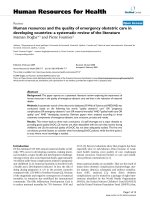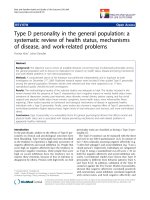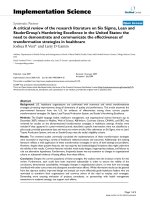BLOCKCHAIN: A SYSTEMATIC REVIEW OF CURRENT RESEARCH IN BUSINESS AND ECONOMICS
Bạn đang xem bản rút gọn của tài liệu. Xem và tải ngay bản đầy đủ của tài liệu tại đây (801.8 KB, 14 trang )
<span class="text_page_counter">Trang 1</span><div class="page_container" data-page="1">
R E V I E WOpen Access
A systematic review of blockchain Min Xu<sup>*</sup> , Xingtong Chen and Gang Kou
<small>* Correspondence:</small>
<small>Southwestern University of Financeand Economics, Chengdu, China</small>
Blockchain is considered by many to be a disruptive core technology. Althoughmany researchers have realized the importance of blockchain, the research ofblockchain is still in its infancy. Consequently, this study reviews the currentacademic research on blockchain, especially in the subject area of business andeconomics. Based on a systematic review of the literature retrieved from the Web ofScience service, we explore the top-cited articles, most productive countries, andmost common keywords. Additionally, we conduct a clustering analysis and identifythe following five research themes: “economic benefit,” “blockchain technology,”“initial coin offerings,” “fintech revolution,” and “sharing economy.” Recommendationson future research directions and practical applications are also provided in thispaper.
Keywords: Blockchain, Systematic literature review, Business and economics,CiteSpace
The concepts of bitcoin and blockchain were first proposed in 2008 by someone usingthe pseudonym Satoshi Nakamoto, who described how cryptology and an open distrib-uted ledger can be combined into a digital currency application (Nakamoto 2008). Atfirst, the extremely high volatility of bitcoin and the attitudes of many countries towardits complexity restrained its development somewhat, but the advantages of block-chain—which is bitcoin’s underlying technology—attracted increasing attention. Someof the advantages of blockchain include its distributed ledger, decentralization, infor-mation transparency, tamper-proof construction, and openness. The evolution ofblockchain has been a progressive process. Blockchain is currently delimited to Block-chain 1.0, 2.0, and 3.0, based on their applications. We provide more details on thethree generations of blockchain in the Appendix. The application of blockchain tech-nology has extended from digital currency and into finance, and it has even graduallyextended into health care, supply chain management, market monitoring, smart en-ergy, and copyright protection (Engelhardt 2017; Hyvarinen et al.2017; Kim and Las-kowski2018; O'Dair and Beaven2017; Radanovic and Likic2018; Savelyev2018).
Blockchain technology has been studied by a wide variety of academic disciplines.For example, some researchers have studied the underlying technology of blockchain,such as distributed storage, peer-to-peer networking, cryptography, smart contracts,and consensus algorithms (Christidis and Devetsikiotis 2016; Cruz et al. 2018; Kraft
2016). Meanwhile, legal researchers are interested in the regulations and laws<small>© The Author(s). 2019 Open Access This article is distributed under the terms of the Creative Commons Attribution 4.0 InternationalLicense ( which permits unrestricted use, distribution, and reproduction in any medium,provided you give appropriate credit to the original author(s) and the source, provide a link to the Creative Commons license, and</small>
</div><span class="text_page_counter">Trang 2</span><div class="page_container" data-page="2">governing blockchain-related technology (Kiviat 2015; Paech 2017). As the old sayinggoes: scholars in different disciplines have many different analytical perspectives and“speak many different languages.” This paper focuses on analyzing and combing papersin the field of business and economics. We aim to identify the key nodes (e.g., the mostinfluential articles and journals) in the related research and to find the main researchthemes of blockchain in our discipline. In addition, we hope to offer some recommen-dations for future research and provide some suggestions for businesses that wish toapply blockchain in practice.
This study will conduct a systematic and objective review that is based on data statisticsand analysis. We first describe the overall number and discipline distribution ofblockchain-related papers. A total of 756 journal articles were retrieved. Subsequently, werefined the subject area to business and economics, and were able to add 119 articles toour further analysis. We then explored the influential countries, journals, articles, andmost common keywords. On the basis of a scientific literature analysis tool, we were ableto identify five research themes on blockchain. We believe that this data-driven literaturereview will be able to more objectively present the status of this research.
The rest of this paper is organized as follows. In the next section, we provided anoverview of the existing articles in all of the disciplines. We holistically describe thenumber of papers related to blockchain and discipline distribution of the literature. Wethen conduct a further analysis in the subject field of business and economics, wherewe analyze the countries, publications, highly cited papers, and so on. We also pointout the main research themes of this paper, based on CiteSpace. This is followed byrecommendations for promising research directions and practical applications. In thelast section, we discuss the conclusions and limitations.
Overview of the current research
In our research, we first conducted a search on Web of Science Core Collection(WOS), including four online databases: Science Citation Index Expanded (SCI-EX-PANDED), Social Sciences Citation Index (SSCI), Arts & Humanities Citation Index(A&HCI), and Emerging Sources Citation Index (ESCI). We chose WOS because thepapers in these databases can typically reflect scholarly attention towards blockchain.When searching the term “blockchain” as a topic, we found a total of 925 records inthese databases. After filtering out the less representative record types, we reducedthese papers to 756 articles that were then used for further analysis. We extracted thefull bibliographic record of the articles that we identified from WOS, including infor-mation on the title, author, keywords, abstract, journal, year, and other publication in-formation. These records were then exported to CiteSpace for subsequent analysis.CiteSpace is a scientific literature analysis tool that enables us to visualize trends andpatterns in the scientific literature (Chen2004). In this paper, CiteSpace is used to visu-ally represent complex structures for statistical analysis and to conduct cluster analysis.
Table1shows the number of academic papers published per year. We have listed thenumber of all of the publications in WOS, the number of articles in all of the disci-plines, and the number of articles in business and economics subjects. It should benoted that we retrieved the literature on March 25, 2019. Therefore, the number of ar-ticles in 2019 is relatively small. The number of papers has continued to grow in recentyears, which suggests that there is a growing interest in blockchain. All of the extracted
</div><span class="text_page_counter">Trang 3</span><div class="page_container" data-page="3">papers in WOS were published after 2015, which is seven years after blockchain andbitcoin was first described by Nakamoto. In these initial seven years, many papers werepublished online or indexed by other databases. However, we have not discussed thesepapers here. We only chose WOS, representative high-level literature databases. This isthe most common way of doing a literature review (Ipek2019).
In the 756 articles that we managed to retrieve, the three most common keywordsbesides blockchain are bitcoin, smart contract, and cryptocurrency, with the frequencyof 113 times, 72 times, and 61 times, respectively. This shows that the majority of theliterature mentions the core technology of blockchain and its most widely known appli-cation—bitcoin.
In WOS, each article is assigned to one or more subject categories. Therefore,we use CiteSpace to visualize what research areas are involved in current researchon blockchain. Figure 1 shows a network of such subject categories. The mostcommon category is Computer Science, which has the largest circle, followed byEngineering and Telecommunications. Business and Economics is also a common
Table 1 Number of academic papers on blockchain
</div><span class="text_page_counter">Trang 4</span><div class="page_container" data-page="4">subject area for blockchain. Consequently, in the following session, we will conductfurther analysis in this field.
Articles in business and economics
Given that the main objective of our research was to understand the research of chain in the area of economics and management, we conduct an in-depth analysis onthe papers in this field. We refined the research area to Business and Economics, andwe finally retrieved 119 articles from WOS. In this session, we analyzed their publishedjournals, research topics, citations, and so on, to depict the research status of block-chain in the field of business and economics more comprehensively.
block-There are several review papers on blockchain. Each of these paper contains a mary of multiple research topics, instead of a single topic. We do not include these lit-erature reviews in our paper. However, it is undeniable that these articles also play animportant role on the study of blockchain. For instance, Wang et al. (2019) investigatethe influence of blockchain on supply chain practices and policies. Zhao et al. (2016)suggest blockchain will widely adopted in finance and lead to many business innova-tions and research opportunities.
The United States, the United Kingdom, and Germany are the top three countries by thenumber of papers published on blockchain; the specific data are shown in Table 2. TheUnited States released more papers than the other countries and it produced more thanone-third of the total articles. As of the time of data collection, China contributed 11 pa-pers, ranking fourth. The 119 papers in total are drawn from 17 countries and regions. Incontrast, we searched “big data” and “financial technology” in the same way, and found286 papers on big data that came from 24 countries, while 779 papers on fintech camefrom 43 countries. This shows that blockchain is still an emerging research field, and itneeds more countries and scholars to join in the research effort.
We counted the journals published in these papers and we found that 44 journals lished related papers. Table 3lists the top 11 journals to have published blockchain re-search. First is “Strategic Change: Briefings in Entrepreneurial Finance,” followed by“Financial Innovation” and “Asia Pacific Journal of Innovation and Entrepreneurship.”The majority of papers in the journal“Strategic Change” were published in 2017, exceptfor one in 2018 and one in 2019. Papers in the journal “Financial Innovation” were
pub-Table 2 Main research countries
</div><span class="text_page_counter">Trang 5</span><div class="page_container" data-page="5">generally published in 2016, with one published in 2017 and one in 2019. All five of thepapers in the journal “Asia Pacific Journal of Innovation and Entrepreneurship” werepublished in 2017.
Cited references
Table4presents the top six cited publications, which were cited no less than five times.The list consists of three books and three journal articles. Some of these publicationsintroduce blockchain from a technical perspective and some from an application perspec-tive. Swan’s (2015) book illustrates the application scenarios of blockchain technology. Inthis book, the author describes that blockchain is essentially a public ledger with potentialas a decentralized digital repository of all assets—not only tangible assets but also intan-gible assets such as votes, software, health data, and ideas. Tapscott and Tapscott’s (2016)book explains why blockchain technology will fundamentally change the world. Yermack(2017) points out that blockchain will have a huge impact and will present many chal-lenges to corporate governance. Böhme et al. (2015) introduce bitcoin, the first and mostfamous application of blockchain. Narayanan et al. (2016) also focus on bitcoin and ex-plain how bitcoin works at a technical level. Lansiti and Lakhani (2017) argue it will takeyears to truly transform the blockchain because it is a fundamental rather than destructivetechnology, which will not drive implementation, and companies will need other incen-tives to adopt blockchain.
Table 3 Top 11 journals publishing blockchain research
Table 4 Cited references
<small>Blockchain revolution: how the technology behind bitcoin is changingmoney, business, and the world</small>
<small>(Tapscott andTapscott2016)</small>
<small>Bitcoin and Cryptocurrency Technologies: A ComprehensiveIntroduction</small>
</div><span class="text_page_counter">Trang 6</span><div class="page_container" data-page="6">Most influential articles
These 119 papers were cited 314 times in total, and 270 times without citations. The number of articles that they cited are 221, of which 197 are non-self-citations. The most influential articles with more than 10 citations are listed inTable 5. The most popular article in our dataset is Lansiti and Lakhani (2017),with 49 citations in WOS. This suggests that this article has had a strong influenceon the research of blockchain. This paper believes there is still a distance to thereal application of the blockchain. The other articles describe how blockchain af-fects and works in various areas, such as financial services, organizational manage-ment, and health care. Since blockchain is an emerging technology, it isparticularly necessary to explore how to combine blockchains with various indus-tries and fields.
self-By comparing the journals in Tables 4 and 5, we find that some journals peared in both of the lists, such as Financial Innovation. In other words, papers onblockchain are more welcomed in these journals and the journal’s papers are highlyrecognized by other scholars. Meanwhile, although journals such as Harvard Busi-ness Review have only published a few papers related to blockchain, they are highlycited. Consequently, the journals in both of these lists are of great importance.
ap-Research themes
Addressing research themes is crucial to understanding a research field and exploringfuture research directions. This paper explored the research topic based on keywords.Keywords are representative and concise descriptions of article content. First, we ana-lyzed the most common keywords used by the papers. We find that the top five mostfrequently used keywords are “blockchain,” “bitcoin,” “cryptocurrency,” “fintech,” and“smart contract.” Although the potential for blockchain applications goes way beyonddigital currencies, bitcoin and other cryptocurrencies—as an important blockchainapplication scenario in the finance industry—were widely discussed in these articles.Smart contracts allow firms to set up automated transactions in blockchains, thus
Table 5 Most cited articles
<small>15Toward Blockchain-Based Accounting and Assurance(Dai and</small>
<small>Journal of InformationSystems</small>
<small>Blockchain Technology in the Healthcare Sector</small>
<small>Technology InnovationManagement Review</small>
<small>a</small>
</div><span class="text_page_counter">Trang 7</span><div class="page_container" data-page="7">playing a fundamentally supporting role in blockchain applications. Similar to the erature in all of the subject areas, studies in business and economics also frequentlyuse bitcoin, cryptocurrency, and smart contract as their keywords. The difference isthat many researchers have combined blockchain with finance, regarding it as an im-portant financial technology.
lit-After analyzing the frequency of keywords, we conducted a keywords clustering lysis to identify the research themes. As shown in Fig. 2, five clusters were identifiedthrough the log-likelihood ratio (LLR) algorithm in Citespace, they are: cluster #0“eco-nomic benefit,” cluster #1 “blockchain technology,” cluster #2 “initial coin offerings,”cluster #3“fintech revolution,” and cluster #4 “sharing economy.”
ana-Many researchers have studied the economic benefits of blockchain. They suggestthe application of blockchain technology to streamline transactions and settlementprocesses can effectively reduce the costs associated with manual operations. Forinstance, in the health care sector, blockchain can play an important role in cen-tralizing research data, avoiding prescription drug fraud, and reducing administra-tive overheads (Engelhardt 2017). In the music industry, blockchain could improvethe accuracy and availability of copyright data and significantly improve the trans-parency of the value chain (O'Dair and Beaven 2017). Swan (2017) expound theeconomic value of block chain through four typical applications, such as digitalasset registries, leapfrog technology, long-tail personalized economic services, andpayment channels and peer banking services.
The representative paper for cluster “blockchain technology” was published byLansiti and Lakhani (2017), who analyze the inherent features of blockchain andpointed out that we still have a lot to do to apply blockchain extensively. Other re-searchers have explored the characteristics of blockchain technology from multipleperspectives. For example, Xu (2016) explores the types of fraud and malicious ac-tivities that blockchain technology can prevent and identifies attacks to which
<small>Fig. 2 Disciplines and topics</small>
</div><span class="text_page_counter">Trang 8</span><div class="page_container" data-page="8">blockchain remains vulnerable. Meanwhile, Aune et al. (2017) propose a graphic approach to solve information leakage problems on a blockchain.
crypto-Initial coin offering (ICO) is also a research topic of great concern to scholars. Manyresearchers analyze the determinants of the success of initial coin offerings (Adhami etal. 2018; Ante et al. 2018). For example, Fisch (2019) assesses the determinants of theamount raised in ICOs and discusses the role of signaling ventures’ technological cap-abilities in ICOs. Deng et al. (2018) argue the outright ban on ICOs might hamperrevolutionary technological development and they provided some regulatory reformsuggestions on the current ICO ban in China.
Many researchers have explored blockchain’s support for various industries. The fintechrevolution brought by the blockchain has received extensive attention (Yang and Li2018).Researchers agree that this nascent technology may transform traditional trading methodsand practice in financial industry (Ashta and Biot-Paquerot2018; Chen et al. 2017; Kimand Sarin2018). For instance, Gomber et al. (2018) discuss transformations in four areasof financial services: operations management, payments, lending, and deposit services.Dierksmeier and Seele (2018) address the impact of blockchain technology on the natureof financial transactions from a business ethics perspective.
Another cluster corresponds to the sharing economy. A handful of researchers have cused on this field and they have discussed the supporting role played by blockchain inthe sharing economy. Pazaitis et al. (2017) describe a conceptual economic model ofblockchain-based decentralized cooperation that might better support the dynamics of so-cial sharing. Sun et al. (2016) discuss the contribution of emerging blockchain technolo-gies to the three major factors of the sharing economy (i.e., human, technology, andorganization). They also analyze how blockchain-based sharing services contribute tosmart cities.
In this section, we will discuss the following issues: (1) What will be the future search directions for blockchain? (2) How can businesses benefit from blockchain?We hope that our discussions will be able to provide guidance for future academicdevelopment and social practice.
re-(1) What will be the future research directions for blockchain?
In view of the five themes mentioned in this paper, we provide some dations for future research in this section.
recommen-The economic benefits of blockchain have been extensively studied in previousresearch. For individual businesses, it is important to understand the effects ofblockchain applications on the organizational structure, mode of operation, andmanagement model of the business. For the market as a whole, it is important todetermine whether blockchain can resolve the market failures that are broughtabout by information asymmetry, and whether it can increase market efficiencyand social welfare. However, understanding the mechanisms through which block-chain influences corporate and market efficiency will require further academicinquiry.
</div><span class="text_page_counter">Trang 9</span><div class="page_container" data-page="9">For researchers of blockchain technology, this paper suggests that we should paymore attention to privacy protection and security issues. Despite the fact that all ofthe blockchain transactions are anonymous and encrypted, there is still a risk ofthe data being hacked. In the security sector, there is a view that absolute securitycan never be guaranteed wherever physical contact exists. Consequently, the ques-tion of how to share transaction data while also protecting personal data privacyare particularly vital issues for both academic and social practice.
Initial coin offering and cryptocurrency markets have grown rapidly. They bringmany interesting questions, such as how to manage digital currencies. Althoughthe majority of the previous research has focused on the determinants of successof initial coin offerings, we believe that future research will discuss how to regulatecryptocurrency and the ICO market. The success of blockchain technology indigital currency applications prior to 2015 caught the attention of many traditionalfinancial institutions. As blockchain has continued to reinvent itself, in 2019 it isnow more than capable of meeting the needs of the finance industry. We believethat blockchain is able to achieve large-scale applications in many areas of finance,such as banking, capital markets, Internet finance, and related fields. The deep in-tegration of blockchain technology and fintech will continue to be a promising re-search direction.
The sharing economy is often defined as a peer-to-peer based activity of sharinggoods and services among individuals. In the future, sharing among enterprisesmay become an important part of the new sharing economy. Consequently, build-ing the interconnection of blockchains may become a distinct trend. These inter-connections will facilitate the linkages between processes of identity authentication,supply chain management, and payments in commercial operations. They will alsoallow for instantaneous information exchange and data coordination among enter-prises and industries.
(2) How can businesses benefit from blockchain?
Businesses can leverage blockchains in a variety of ways to gain an advantage overtheir competitors. They can streamline their core business, reduce transaction costs,and make intellectual property ownership and payments more transparent and auto-mated (Felin and Lakhani 2018). Many researchers have discussed the application ofblockchain in business. After analyzing these studies, we believe that enterprises canconsider applying blockchain technology in the four aspects that follow.
(a) Accounting settlement and crowdfunding
Bitcoin or another virtual currency supported by blockchain technology can helpbusinesses to solve funding-related problems. For instance, cryptocurrencies sup-port companies who wish to implement non-cash payments and accounting settle-ment. The automation of electronic transaction management accounting improvesthe level of control of monetary business execution, both internally and externally(Zadorozhnyi et al. 2018). In addition, blockchain technology represents an emer-ging source of venture capital crowdfunding (O'Dair and Owen 2019). Investors or
</div><span class="text_page_counter">Trang 10</span><div class="page_container" data-page="10">founders of enterprises can obtain alternative entrepreneurial finance through tokensales or initial coin offerings. Companies can handle financial-related issues moreflexibly by holding, transferring, and issuing digital currencies that are based onblockchain technology.
(b) Data storage and sharing
As the most valuable resource, data plays a vital role in every enterprise. chain provide a reliable storage and efficient use of data (Novikov et al. 2018). Asa decentralized and secure ledger, blockchain can be used to manage digital assetfor many kinds of companies (Dutra et al. 2018). Decentralized data storage meansyou do not give the data to a centralized agency but give it instead to peoplearound the world because no one can tamper with the data on the blockchain.Businesses can use blockchain to store data, improve the transparency and securityof the data, and prevent the data from being tampered with. At the same time,blockchain also supports data sharing. For instance, all of the key parties in the ac-counting profession leverage an accountancy blockchain to aggregate and share in-stances of practitioner misconduct across the country on a nearly real-time basis(Sheldon 2018).
Block-(c) Supply chain management
Blockchain technology has the potential to significantly change supply chain ment (SCM) (Treiblmaier2018). Recent adoptions of the Internet of Things and block-chain technologies support better supply-chain provenance (Kim and Laskowski2018).When the product goes from the manufacturer to the customer, important data are re-corded in the blockchain. Companies can trace products and raw materials to effect-ively monitor product quality.
manage-(d) Smart trading
Businesses can build smart contracts on blockchain, which is widely used to ment business collaborations in general and inter-organizational business processes inparticular. Enterprises can automate transactions based on smart contracts on blockchains without manual confirmation. For instance, businesses can file taxes automatic-ally under smart contracts (Vishnevsky and Chekina2018).
This paper reviews 756 articles related to blockchain on the Web of Science CoreCollection. It shows that the most common subject area is Computer Science,followed by Engineering, Telecommunications, and Business and Economics. In theresearch of Business and Economics, several key nodes are identified in the litera-ture, such as the top-cited articles, most productive countries, and most commonkeywords. After a cluster analysis of the keywords, we identified the five mostpopular research themes: “economic benefit,” “blockchain technology,” “initial coinofferings,” “fintech revolution,” and “sharing economy.”
</div>








